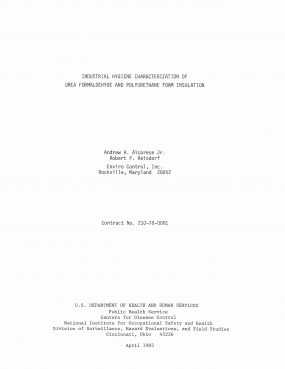Industrial Hygiene Characterization of Urea Formaldehyde and Polyurethane Foam Insulation
April 1983
DHHS (NIOSH) Publication Number 83-108

As part of a study of the foam insulation industry, industrial hygiene surveys were conducted at eight urea-formaldehyde and polyurethane (PU) thermal insulation manufacturing and application facilities, involving personal and area monitoring to determine exposure levels to chemical and physical agents. In the urea- formaldehyde industry, the levels of formaldehyde (50000) exposure ranged from a time weighted average (TWA) of 18 parts per million (ppm) to a peak of 5 to 10ppm at production facilities and 0.08 to 2.4ppm at application sites. Ammonia (7664417) levels during ammonia drum pump stem removal reached 300ppm; all other chemicals were generally below the detection limits. Noise levels at one facility were in excess of established limits. In the polyurethane industry, the levels of methylenebisphenyl-isocyanate (101688) (MDI) ranged from less than 0.0008 to peaks of 0.002 to 0.005ppm at manufacturing facilities and 0.002 to 0.0068ppm at application sites; the OSHA limit of 0.02ppm for toluene-diisocyanate (584849) was exceeded at one application site. Materials considered appropriate for similar studies included calcium-silicate, cellulose (in the form of cotton fiber, macerated paper and wood fiber), ceramic fiber, diatomaceous earth, gypsum, isocyanurates, magnesium- carbonate, perlite, polystyrene and vermiculite.
- Page last reviewed: April 10, 2017
- Page last updated: June 27, 2017
- Content source:
- National Institute for Occupational Safety and Health Education and Information Division


 ShareCompartir
ShareCompartir